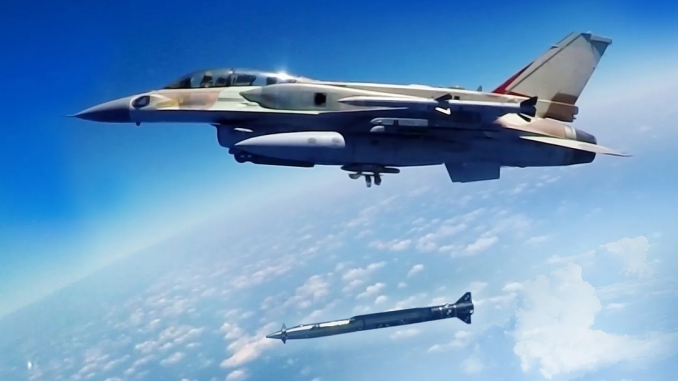Peloni: Skullduggery within the US Intel community provides a telling cost of the US-Israel coordination which does more than impair Israeli operations against Iran, as it casts a further pall upon the US-Israeli alliance. Grasping the permanence of the US Bureaucratic state, and the lack of accountability within the US establishment, how could Israel knowingly come to trust the US with its secrets in the future? As the usual stage players in Congress stammer with their routinely meaningless fits of furry and empty demands for accountability, the damage thus far incurred is neither fully known nor even necessarily at an end. And the implications of this not too subtle betrayal is no doubt being weighed carefully by nations looking to coordinate more closely with the US, and those who are already captured in such a coordination as is Israel.
Stephen Bryen | Weapons & Strategy | Oct 20, 2024
 Israeli F-16 Fighting Falcon Launches Rampage Cruise Missile
Israeli F-16 Fighting Falcon Launches Rampage Cruise Missile
“Middle East Spectator,” is a pro-regime Telegram outlet based in Tehran, as all media channels based in Tehran are – by law. Last week, Middle East Spectator leaked two sensitive intelligence documents The documents originated in the US National Geospatial-Intelligence Agency (NGA), and the information pertained to Israel’s preparation to retaliate for Iranian missile attacks.
I have not re-published the documents leaked on Telegram. Interested readers can go to the link provided above.
Middle East Spectator claims it is an independent operation in Tehran. It says it got the documents from an “informed source in the US intelligence community.” If we take this at face value, then a source in the intelligence community contacted the Spectator and shared the two documents. To further clarify, in a subsequent post Spectator says the source was in the US Defense Department.
Because “news” and information in Iran is very tightly controlled, Spectator could only publish these documents with permission from the regime.
It is extraordinarily valuable material that Iran can, and likely will, use to prepare its defenses.
One of the two leaked documents is classified above top secret. That document is headlined as NOFORN which means that the document cannot be shared with foreign governments. Assuming that the documents were not shared with allies (such as the Five Eyes group that have extraordinary access to US intelligence information), that information strengthens the claim made by the Spectator, that the leak came from United States persons or organizations.
The documents describe an Israeli “large force employment exercise” on the 15th and 16th of October. The document was published on Telegraph by the Spectator on the 18th.
Whoever leaked it to Tehran was warning that an Israeli strike was imminent. It also told the Iranians the type of weapons that would be used and probable targets, the latter being mainly Iranian air defense sites and long range radars.
How do we know? The two documents provide highly detailed information on Israeli Air Force preparations for a strike and describes in detail activities at three Israeli air bases subject to massive US surveillance. It carefully identifies the types of cruise missiles Israel was preparing, namely a system called ROCKS (which otherwise may be Israel’s long range Crystal Maze or Crystal Maze II air launched cruise missile) and Golden Dawn, another type of cruise missile that could be a derivative of the Sparrow series that originated as a target system emulating Iranian long range missiles. The report also said that the platform carrying these missiles would be the F-15I, not Israel’s F-35 “Adir” jets. It also indicates the refueling tankers and surveillance platforms Israel would use.
 Israel’s F-35 Adir (Images source: © IDF | Amit Agronov)
Israel’s F-35 Adir (Images source: © IDF | Amit Agronov)
There is more. The lesser classified document (secret level) discussed Israel’s Jericho II medium range ballistic missiles, which are believed to be a critical part of Israel’s nuclear deterrent. The missile is solid fueled and can be silo or TEL-based. The document’s context means that the US accepts Israel has nuclear weapons, although the US has never officially acknowledged that before. The document reveals that Israel may have dispersed the Jericho missiles to prevent them being targeted by Iran. It also says that the US has not detected any preparations by Israel of its Jericho II missiles and concludes any nuclear strike by Israel is unlikely.
There can be no doubt that the leak of geospatial-origin intelligence has brought significant harm to Israel. It is also likely much more sensitive intelligence was leaked to the Iranians, which Iran may be protecting from public disclosure. Some releases on the Spectator channel admit as much.
Why would the Iranian government (either via Spectator or by giving permission to Spectator) leak ANY of the information?
Some speculate it was to convince Israel that the retaliation plan was known to Iran – thus deterring Israel from an attack that the Iranian government REALLY didn’t want to face. Second, perhaps, it was to warn (boast?) that Iran was being supplied with secret information by the United States, making Israel worry about what else had been compromised.
Consider this.
The Iranian leak was published on October 18th. On the 19th, an alleged Hezbollah-origin drone attacked Israeli Prime Minister Benjamin Netanyahu’s private home in Caesarea near the coast. Accurately targeting Netanyahu’s home required “scene matching,” as any drone from Lebanon, Syria or Iraq would likely have been outside of radio control communication. “Scene matching” would require significant intelligence preparation.

Was there confidence Netanyahu would be at home during the attack? Or confidence that he wouldn’t be – striking the house knowing he wasn’t there would be another way of telling Israel what Iran knows without facing the retaliation that would surely follow an actual assassination.
Were US assets complicit? In other words was the leak a violation of law or was it an act by the administration or some in the administration with political motives? No one can say, yet.
All of this is likely to cause a significant reassessment in Israel. At minimum, the Israelis will have the opinion that US intelligence is unreliable and penetrated. Beyond that, some will understand the US to be overtly hostile and acting against Israel. (After the drone attack, the Prime Minister received phone calls from heads of state and from former President Trump and US House Speaker Mike Johnson. Neither President Biden nor Vice President Harris called.)
In the real world this is a very sad development. Israel has some of the best human intelligence (HUMINT) in the world and has significant access to Iran’s nuclear programs. Israel has, on many occasions, warned friendly (and not so friendly) countries about threats, including foreign leaders, the Mossad and other intelligence centers in Israel have detected. Leaks like this put a severe chill on intelligence cooperation and directly harms the US.
The US has apparently launched an investigation, according to House of Representatives Speaker Mike Johnson. Documents of this type are often sent via secure internet to security-cleared personnel. There could be hundreds, perhaps even more, with access. It might be possible to review time stamps on those who accessed or copied the documents, which would potentially help narrow the search. It may also be possible to track documents sent outside the US using NSA’s massive capabilities. Much depends on whether the investigation undertaken is serious.
One suggestion being floated is that maybe the documents were hacked. But such sensitive information is not only carried on classified channels, but it is also encrypted, making hacking less likely to yield useful results. For the record, there are no public reports of any hacks of US security information.
It isn’t clear what Israel will do. It would be reckless to retaliate now that at least some of Israel’s plans and preparations have been leaked – which was the whole idea. Israel had already reportedly agreed with the US not to strike either Iran’s oil and nuclear facilities. Will that agreement hold now, or will Israel consider the agreement void?
Beyond that, Israel has to be concerned that its other operations – against Iranian proxies from the Red Sea to Gaza, Lebanon and Syria also are at risk because of US intelligence leaks.



Good idea, Rafi! 🙂
The leaker appears to be an Iranian woman who worked in the Pentagon who had top classified clearance, who has long been suspected of being a spy by Jewish organizations.
US spied on Israel is how they obtained information. Then someone leaked information to Iran.
Prior to Israel attacking Iran they should provide US disinformation and wait for it to be leaked to Iran, so to throw off track on actual attack. Maybe this has or will occur.
I don’t think it was shared voluntarily. They found out by satellites.
We can probably thank Barack HUSSEIN Obama for encouraging these leaks. Vote for Trump and pray he wins.
I have my thoughts on this… but they’re classified…
WHY IN HELL WOULD ISRAEL EVER AGREE TO SHARE ANY INTELLIGENCE OR ATTACK PLANS WITH A HOSTILE FOREIGN POWER?
WHY WOULD ISRAEL AGREE NOT TO STRIKE EITHER THE NUKE OR OIL FACILITIES?